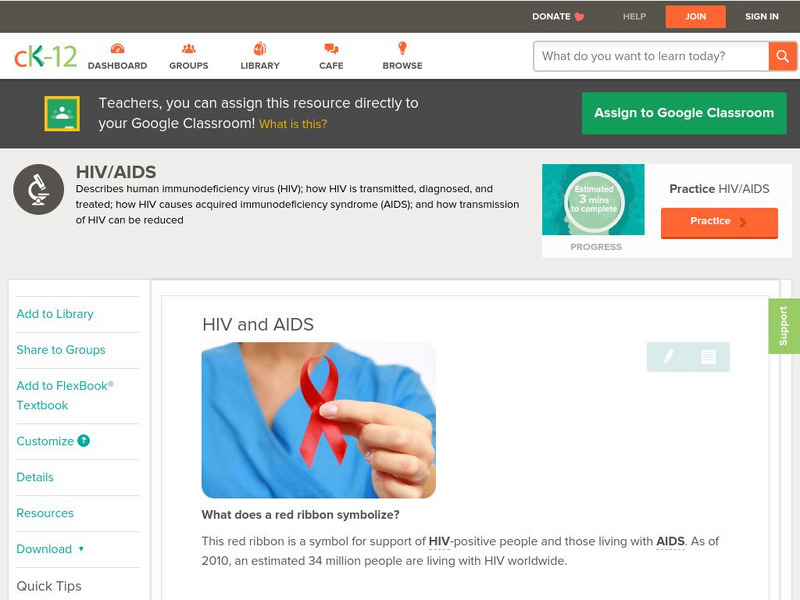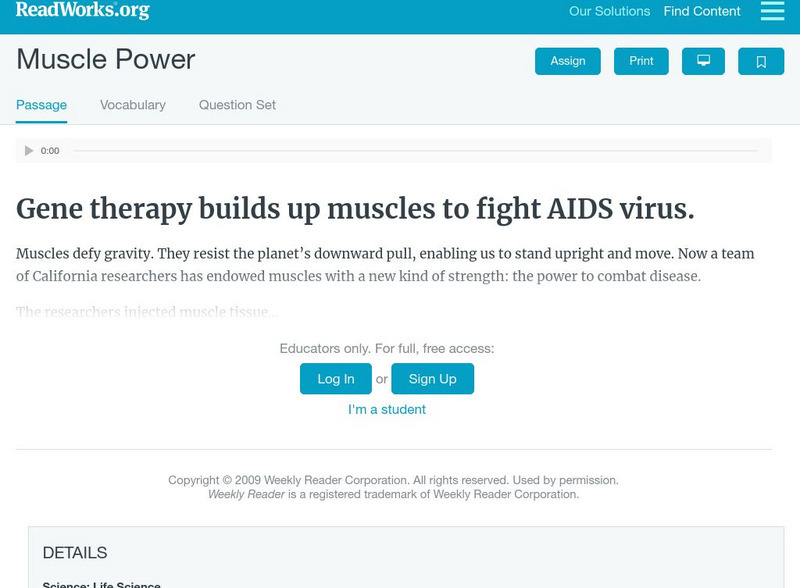Sumanas
Sumanas Inc: Microbial Life: Life Cycle of Hiv, a Retrovirus
Use this tutorial to enhance your understanding of how the human immunodeficiency virus invades healthy cells of the immune system. [3:15]
CK-12 Foundation
Ck 12: Life Science: Hiv and Aids
[Free Registration/Login may be required to access all resource tools.] HIV, or human immunodeficiency virus, causes AIDS. AIDS stands for "acquired immune deficiency syndrome." It is a condition that causes death and does not have a...
Remedy Health Media
A Look at Theories on the Origin of Hiv
This resource presents an article on the theories of the origin of the AIDS virus (HIV). As was thought for many years, another primate may have first introduced us to this virus. Original resource from 2000 AIDS Project Los Angeles.
National Health Museum
Access Excellence: Development of Polio Vaccines
This site is provided for by Access Excellence. Beginning with a good description of the symptoms and spreading of polio, as well as information on Franklin Delano Roosevelt's battle with polio, this article addresses the development of...
University of Arizona
The Biology Project: Immunology: Hiv and Aids Tutorial
Read this illustrated tutorial about the relationship between the HIV virus and AIDS. Also contains treatment and diagnosis information.
PBS
Pbs Teachers: Structured Treatment Interruption
Determine how studying the evolution of the HIV virus led medical experts to give patients a "holiday" from drugs, weakening the mutated, drug-resistent genes. Discover how this backward evolution works.
Read Works
Read Works: Muscle Power
[Free Registration/Login Required] An informational text about attempts to create a vaccination for he AIDS virus. A question sheet is available to help students build skills in reading comprehension.
Remedy Health Media
The Body: Fact Sheet:ten Things to Know About Hiv/aids
Very good, straightforward facts (as we know it from research) about the HIV virus. Clears up common misconceptions. Original resource from 1998 American Association for World Health.
Remedy Health Media
The Body: Survival of Hiv in the Environment
A good site which explains the effect of the outside the body environment on the HIV virus. This addresses the common fear of airborne transmission. Original resource from 1999 U. S. Center for Disease Control and Prevention.
Remedy Health Media
The Body: Rumors, Myths and Hoaxes About Hiv and Its Transmission
Very good debunking of a variety of misconceptions and myths about the HIV virus. Original resource from 2007 U. S. Center for Disease Control and Prevention.
Remedy Health Media
The Body: When Did Aids Begin?
This site from The Body provides an article summarizing recent research that traces the origins of the HIV virus possible back to the 1940s in Africa. Original resource from 1998 Times Magazine.
Khan Academy
Khan Academy: Swine Flu and Laser Treatment
Read this passage and study the graphics to answer the five-question quiz concerning structure, growth, physiology, and genetics of prokaryotes and viruses.
Khan Academy
Khan Academy: Two Flu Vaccines (Tiv and Laiv)
Understand the differences between TIV (dead virus) and LAIV (alive, but weakened virus) and the population that should get which one.
Khan Academy
Khan Academy: Flu Shift and Drift
Discover how Type B Influenza virus has genetic drift, whereas Type A Influenza virus has genetic drift and shift.
Khan Academy
Khan Academy: Genetic Shift in Flu
An explanation of how genetic material in Type A flu virus can get shuffled around to create brand new types of viruses.
Khan Academy
Khan Academy: Poliomyelitis Pathophysiology
How does the polio virus cause polio myelitis? An explanation of the polio virus entering the mouth and replicating in the throat and intestines where it then connects to muscles from the neurons of the central nervous system.
Khan Academy
Khan Academy: Naming the Flu: H Something, N Something
An explanation of what the names H1N1 and H3N2 mean and why they are helpful in keeping track of different flu viruses.
Khan Academy
Khan Academy: The Three Types of Flu
An explanation of the three types of influenza viruses (Type A, Type B, and Type C) and what makes them different from one another.
Khan Academy
Khan Academy: What Is the Flu?
Learn the difference between the cold and the flu, and how viruses can complicate diagnosis.
CK-12 Foundation
Ck 12: Barriers to Pathogens
[Free Registration/Login may be required to access all resource tools.] In the following tutorial you will learn about the barriers that keep most pathogens out of the human body.
Other
The Health Success: Nutrition for Your Cells
Basically, the stronger your immune system the healthier you are and, as a consequence, the more protected you are from environmental factors that lead to infection and sickness. If you eat foods that are rich in the nutrients your body...
Ducksters
Ducksters: Biology for Kids: Infectious Disease
Kids learn about infectious diseases including pathogens such as viruses, bacteria, parasites, and fungi as well as transmission and other types of diseases.
Other
Miniclip: Sneeze
Play this educational interactive online game to learn how sneezing infects other humans with a virus. Children and the elderly are the easiest to infect because of their immune systems. Includes facts about the common cold.

















